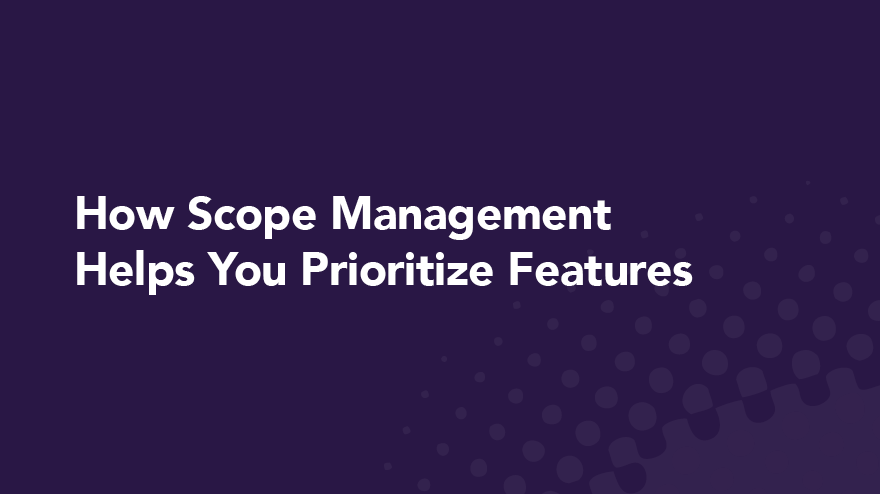Agile workflow
7 min read

How Scope Management Helps You Prioritize Features
Mon Mar 22 2021
Scope management — planning, estimating, and tracking a project’s duration and cost — is challenging. In a magical world, your project's deliverables will be finished on time and within budget. The project team won't break a sweat, and stakeholders will be amazed at the results of the entire project.
But magic is hard, and sometimes, that’s because the scope changes. There are many reasons for this. Stakeholders make change requests, new product ideas can be tempting, or slight additions to functionality seem feasible. All these things can lead to project deliverables being late or added features that are not necessary. A good scope management process can help to avoid this.
Scope management is a critical skill for a project manager. Project scope, simply defined, is the amount of work it takes to complete a project. Part of the project manager's role is managing scope in a way that delivers the project within its estimated timeframe and budget.
We'll discuss the steps it takes to estimate the scope of a project — the planning phase, the scope definition, breaking down the work into parts, and how to validate your scope estimation before your project starts. Then, we'll focus on how to use an agile project scope management approach to limit problems like scope creep and keep your project on track.
Finally, we'll learn how critical scope management is for program management — when your organization has several related projects to achieve business objectives.
It's all kind of like magic. 🎩 🐰
Creating your project scope management plan

Every successful project has a plan. A planning phase gives the project team a clear direction and a good understanding of the amount of work it will take to fulfill the project requirements. In project scope management, there are best practices to follow in the scoping process.
The objective is to contain additional scope from being added. If this process is followed on all of the projects in a larger program, then you can avoid one project delaying another that depends on it. Following these tips will set you up for success once the project is underway.
Project planning and requirements gathering
A good scope management plan begins with a planning phase. During this time, requirements and feedback are collected from stakeholders. These requirements should ultimately fulfill the objectives of the project, and all participants should understand how they help achieve a project's business objectives.
Requirements management is the process of gathering, documenting, analyzing, and prioritizing feedback from stakeholders. There are a number of techniques you can use to collect feedback, including interviews, surveys, workshops, and brainstorming sessions. Don't feel locked into any one way to gather requirements — there are many effective ways to do it!
Defining your project and its scope
A great way to capture your project scope management plan is in a project scope statement. This scope document helps to define the project's scope (e.g., timeline, allocation of resources), its business objectives, list its deliverables, describe its acceptance criteria, and include the assumptions it relies on.
It's also a good idea to list what isn’t included in the project, even if those things were discussed during the requirements gathering phase. Suppose you had discussed a feature with a stakeholder in the planning phase. They were excited about it. But, when you defined your scope, you realized that feature would break the budget, and it didn’t fall into the core requirements of the project. You want to highlight its exclusion now — not when the project is completed. This helps set stakeholder expectations early in the process and avoid confusion or disappointment when the project finishes.
Work breakdown structure — turning a boulder into rocks

Ok, so now we have a plan and a scope definition. How do we get the work done? A work breakdown structure (WBS) is a process of breaking a high-level scope statement into smaller parts or tasks. This approach fits nicely in an agile project management framework because these tasks can be mapped to user stories or be contained within a sprint.
Think of it like this: What's the best way to move a boulder? You could try to get your whole team to move the whole thing at once. But a better strategy is to break the boulder into rocks small enough to be carried individually.
Project and scope validation
Now it's time to review your plan with your stakeholders and team members. Before the project begins, make sure these questions are answered:
- Has the team agreed on reasonable effort, time, and budget estimations for the project?
- Will the defined output of the project meet your stakeholders' business objectives?
- Is anything blocking the team from completing the work?
- Is the scope baseline approved?
The scope baseline is the approved version of the project management plan (what was defined in your project scope statement). It should be accepted by the project's stakeholders and used for comparison purposes. For example, changes in the project plan need to be formally approved and documented. To do this, the team needs to determine if the changes will impact the project scope. Looking at the scope baseline when considering project changes helps make this decision.
Managing scope creep in agile

Now it's time for the hard part — ensuring that the amount of time and effort it takes to complete your project stays as close as possible to what was estimated.
Scope creep is the addition of requirements or work that were not agreed upon as part of the project goals. Having a good plan, project and scope definition, and stakeholder validation can all help avoid scope creep. However, even with this preparation, it can still be tempting to add work to your project if you believe you can still hit your targets.
The agile ceremonies — stand-up, sprint planning, sprint review, and retrospective — can help deter scope creep. This is especially true for projects that span multiple sprints.
- Stand up: In this daily meeting, team members can report if there's something blocking their ability to complete their assigned task. If so, rather than add work to unblock the task, another team member can chip in to help.
- Sprint planning: This is an ideal time to agree that the amount of work defined in the next sprint is achievable and meets the next increment of requirements. (We don't need to include anything else in this sprint...right? 😉)
- Sprint review: This is a showcase of the work to demonstrate that the project is on track and no further work should be added to the plan.
- Sprint retrospective: Here, the project team can discuss what went well in the sprint and what didn't. It’s a good time to ask, “Is there anything we can do going forward to make sure we're committing only to the work that was agreed to??
Ok, so now we know how to manage scope in a project. When we have multiple related projects in a program that depend on each other, we can see why good scope management is so important. If one project gets off track, it can have a cascading effect across the entire program.
Use Easy Agile Programs for Jira to manage scope
Jira is a leading tool for project management. It can easily manage sprints and create the tasks needed to fulfill your project's requirements. It’s also great for individual team use. However, when it comes to program management, it's challenging to view all of your related projects in Jira at once.
You can level up how you manage scope for programs that involve multiple, related projects by using Easy Agile Programs for Jira. We can help you map the big picture business objectives from your scope document to ensure stakeholders are aligned on the stated program outcomes. Easy Agile also provides views of cross-team dependencies. If it's clear there's more at risk than just delivery of your own project, everyone might try harder to avoid scope creep.


